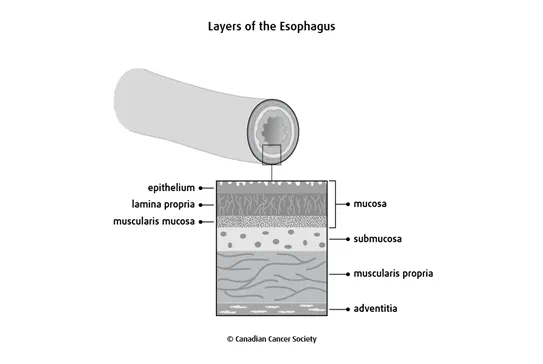Stages of adenocarcinoma of the esophagus
Adenocarcinoma of the esophagus is staged differently than squamous cell carcinoma (SCC) of the esophagus.
The most common staging system for adenocarcinoma of the esophagus is the TNM system. For adenocarcinoma of the esophagus there are 5 stages – stage 0 followed by stages 1 to 4. Often the stages 1 to 4 are written as the Roman numerals I, II, III and IV. Generally, the higher the stage number, the more the cancer has spread. Talk to your doctor if you have questions about staging.
The stages of adenocarcinoma of the esophagus also depend on the grade.
Find out more about staging cancer and grading esophageal cancer.
The esophagus is made up of different layers of tissues. The stage often depends on which layer the tumour has grown into.

Stage 0 (carcinoma in situ)
The tumour is only within the
Stage 1A
The tumour has grown into the connective tissue or muscle layer of the mucosa. It is low grade (grade 1).
Stage 1B
The tumour has grown into the connective tissue or muscle layer of the mucosa. It is moderate grade (grade 2).
Or the tumour has grown into the layer of connective tissue that surrounds the mucosa (submucosa). It is low or moderate grade.
Stage 1C
The tumour has grown into the connective tissue or muscle layer of the mucosa or into the submucosa. It is high grade (grade 3).
Or the tumour has grown into the thick outer muscle layer (muscularis propria). It is low or moderate grade.
Stage 2A
The tumour has grown into the muscularis propria. It is high grade.
Stage 2B
The tumour has grown into the connective tissue or muscle layer of the mucosa or into the submucosa. The cancer has also spread to 1 or 2 nearby lymph nodes. It is any grade.
Or the tumour has grown into the layer of connective tissue that supports and covers the outside of the esophagus (adventitia). It is any grade.
Stage 3A
The tumour has grown into the connective tissue or muscle layer of the mucosa or into the submucosa. The cancer has also spread to 3 to 6 nearby lymph nodes. It is any grade.
Or the tumour has grown into the muscularis propria. The cancer has also spread to 1 or 2 nearby lymph nodes. It is any grade.
Stage 3B
The tumour has grown into the muscularis propria. The cancer has also spread to 3 to 6 nearby lymph nodes. It is any grade.
Or the tumour has grown into the adventitia. The cancer has also spread to 1 to 6 nearby lymph nodes. It is any grade.
Or the tumour has grown into nearby areas such as the
Stage 4A
The tumour has grown into nearby areas such as the pleura, pericardium, diaphragm, peritoneum or vein that runs along the spinal column. The cancer has also spread to 3 to 6 nearby lymph nodes. It is any grade.
Or the tumour has grown into other nearby areas such as the main artery carrying blood out of the heart (aorta),
Or the cancer has spread to 7 or more nearby lymph nodes. It is any grade.
Stage 4B
The cancer has spread to other parts of the body (called distant metastasis), such as to the lungs, liver or stomach. This is also called metastatic esophageal cancer. It is any grade.
Recurrent esophageal cancer
Recurrent esophageal cancer means that the cancer has come back after it has been treated. If it comes back in the same place that the cancer first started, it’s called local recurrence. If it comes back in tissues or lymph nodes close to where it first started, it’s called regional recurrence. It can also recur in another part of the body. This is called distant metastasis or distant recurrence.
